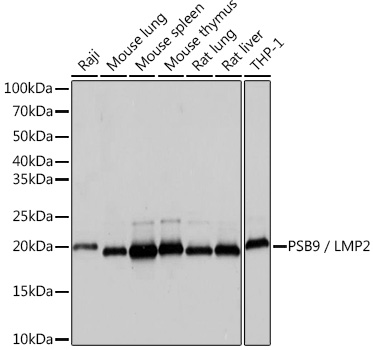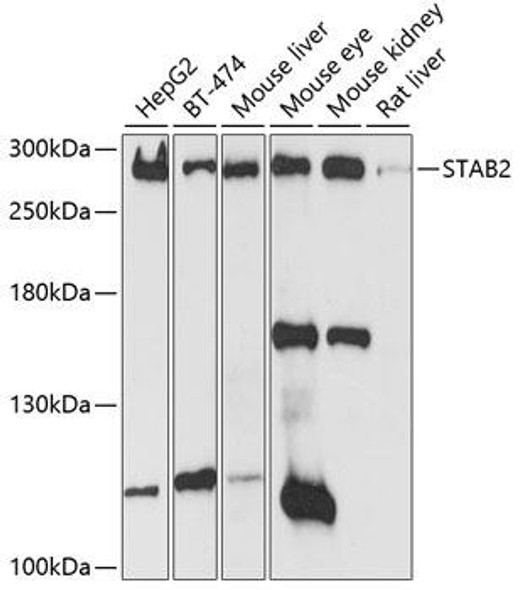Anti-PSB9 / LMP2 Antibody (CAB9549)
- SKU:
- CAB9549
- Product type:
- Antibody
- Reactivity:
- Human
- Mouse
- Rat
- Host Species:
- Rabbit
- Isotype:
- IgG
- Antibody Type:
- Monoclonal Antibody
- Research Area:
- Immunology
Description
| Antibody Name: | Anti-PSB9 / LMP2 Antibody |
| Antibody SKU: | CAB9549 |
| Antibody Size: | 20uL, 50uL, 100uL |
| Application: | WB IHC |
| Reactivity: | Human, Mouse, Rat |
| Host Species: | Rabbit |
| Immunogen: | A synthesized peptide derived from human PSB9 / LMP2 |
| Application: | WB IHC |
| Recommended Dilution: | WB 1:500 - 1:2000 IHC 1:50 - 1:200 |
| Reactivity: | Human, Mouse, Rat |
| Positive Samples: | Raji, Mouse lung, Mouse spleen, Mouse thymus, Rat lung, Rat liver, THP-1 |
| Immunogen: | A synthesized peptide derived from human PSB9 / LMP2 |
| Purification Method: | Affinity purification |
| Storage Buffer: | Store at -20°C. Avoid freeze / thaw cycles. Buffer: PBS with 0.02% sodium azide, 0.05% BSA, 50% glycerol, pH7.3. |
| Isotype: | IgG |
| Sequence: | Email for sequence |
| Gene ID: | 5698 |
| Uniprot: | P28065 |
| Cellular Location: | |
| Calculated MW: | 21kDa |
| Observed MW: | 21KDa |
| Synonyms: | LMP2, PSMB6i, RING12, beta1i |
| Background: | The proteasome is a multicatalytic proteinase complex with a highly ordered ring-shaped 20S core structure. The core structure is composed of 4 rings of 28 non-identical subunits; 2 rings are composed of 7 alpha subunits and 2 rings are composed of 7 beta subunits. Proteasomes are distributed throughout eukaryotic cells at a high concentration and cleave peptides in an ATP/ubiquitin-dependent process in a non-lysosomal pathway. An essential function of a modified proteasome, the immunoproteasome, is the processing of class I MHC peptides. This gene encodes a member of the proteasome B-type family, also known as the T1B family, that is a 20S core beta subunit. This gene is located in the class II region of the MHC (major histocompatibility complex). Expression of this gene is induced by gamma interferon and this gene product replaces catalytic subunit 1 (proteasome beta 6 subunit) in the immunoproteasome. Proteolytic processing is required to generate a mature subunit. [provided by RefSeq, Mar 2010] |
| UniProt Protein Function: | PSMB9: The proteasome is a multicatalytic proteinase complex which is characterized by its ability to cleave peptides with Arg, Phe, Tyr, Leu, and Glu adjacent to the leaving group at neutral or slightly basic pH. The proteasome has an ATP-dependent proteolytic activity. This subunit is involved in antigen processing to generate class I binding peptides. Replacement of PSMB6 by PSMB9 increases the capacity of the immunoproteasome to cleave model peptides after hydrophobic and basic residues. Belongs to the peptidase T1B family. 2 isoforms of the human protein are produced by alternative splicing. |
| UniProt Protein Details: | Protein type:EC 3.4.25.1; Nuclear receptor co-regulator; Protease; Proteasome complex Chromosomal Location of Human Ortholog: 6p21.3 Cellular Component: nucleoplasm; proteasome complex; proteasome core complex; cytoplasm; cytosol Molecular Function:threonine endopeptidase activity; protein binding Biological Process: positive regulation of ubiquitin-protein ligase activity during mitotic cell cycle; negative regulation of ubiquitin-protein ligase activity during mitotic cell cycle; protein polyubiquitination; viral reproduction; apoptosis; antigen processing and presentation of exogenous peptide antigen via MHC class I, TAP-dependent; DNA damage response, signal transduction by p53 class mediator resulting in cell cycle arrest; regulation of apoptosis; antigen processing and presentation of peptide antigen via MHC class I; regulation of ubiquitin-protein ligase activity during mitotic cell cycle; anaphase-promoting complex-dependent proteasomal ubiquitin-dependent protein catabolic process; antigen processing and presentation of exogenous peptide antigen via MHC class I; gene expression; mitotic cell cycle; regulation of amino acid metabolic process; negative regulation of apoptosis; G1/S transition of mitotic cell cycle |
| NCBI Summary: | The proteasome is a multicatalytic proteinase complex with a highly ordered ring-shaped 20S core structure. The core structure is composed of 4 rings of 28 non-identical subunits; 2 rings are composed of 7 alpha subunits and 2 rings are composed of 7 beta subunits. Proteasomes are distributed throughout eukaryotic cells at a high concentration and cleave peptides in an ATP/ubiquitin-dependent process in a non-lysosomal pathway. An essential function of a modified proteasome, the immunoproteasome, is the processing of class I MHC peptides. This gene encodes a member of the proteasome B-type family, also known as the T1B family, that is a 20S core beta subunit. This gene is located in the class II region of the MHC (major histocompatibility complex). Expression of this gene is induced by gamma interferon and this gene product replaces catalytic subunit 1 (proteasome beta 6 subunit) in the immunoproteasome. Proteolytic processing is required to generate a mature subunit. [provided by RefSeq, Mar 2010] |
| UniProt Code: | P28065 |
| NCBI GenInfo Identifier: | 417529 |
| NCBI Gene ID: | 5698 |
| NCBI Accession: | P28065.2 |
| UniProt Secondary Accession: | P28065,P28076, |
| UniProt Related Accession: | P28065 |
| Molecular Weight: | |
| NCBI Full Name: | Proteasome subunit beta type-9 |
| NCBI Synonym Full Names: | proteasome 20S subunit beta 9 |
| NCBI Official Symbol: | PSMB9 |
| NCBI Official Synonym Symbols: | LMP2; PRAAS3; PSMB6i; RING12; beta1i |
| NCBI Protein Information: | proteasome subunit beta type-9 |
| UniProt Protein Name: | Proteasome subunit beta type-9 |
| UniProt Synonym Protein Names: | Low molecular mass protein 2; Macropain chain 7; Multicatalytic endopeptidase complex chain 7; Proteasome chain 7; Proteasome subunit beta-1i; Really interesting new gene 12 protein |
| Protein Family: | Latent membrane protein |
| UniProt Gene Name: | PSMB9 |
| UniProt Entry Name: | PSB9_HUMAN |










